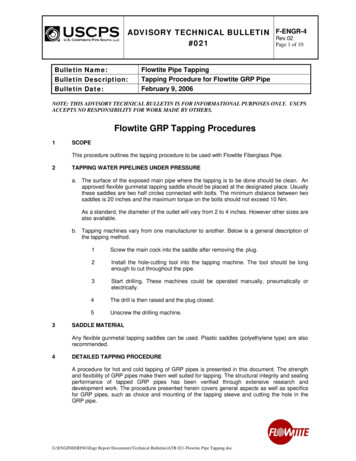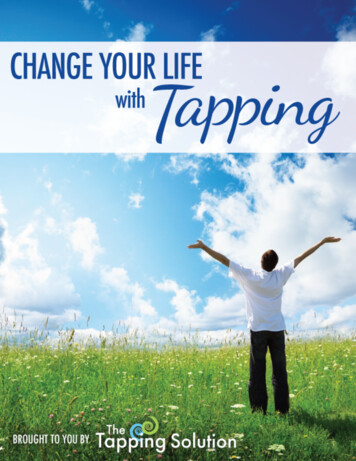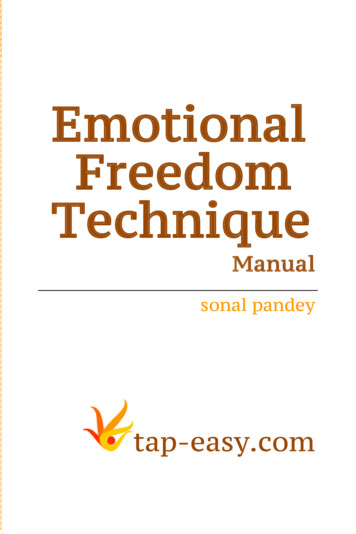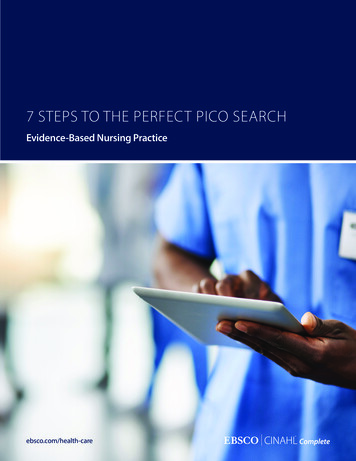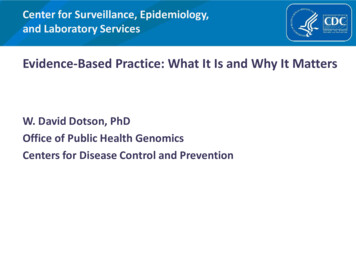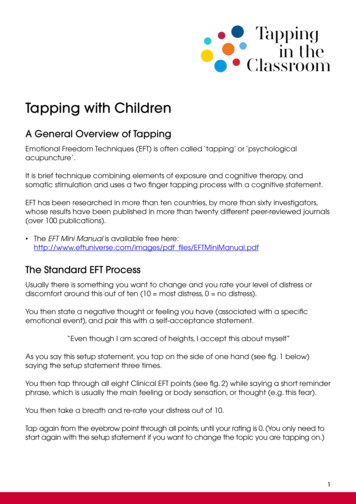
Transcription
Tapping with ChildrenA General Overview of TappingEmotional Freedom Techniques (EFT) is often called ‘tapping’ or ‘psychologicalacupuncture’.It is brief technique combining elements of exposure and cognitive therapy, andsomatic stimulation and uses a two finger tapping process with a cognitive statement.EFT has been researched in more than ten countries, by more than sixty investigators,whose results have been published in more than twenty different peer-reviewed journals(over 100 publications). The EFT Mini Manual is available free here:http://www.eftuniverse.com/images/pdf files/EFTMiniManual.pdfThe Standard EFT ProcessUsually there is something you want to change and you rate your level of distress ordiscomfort around this out of ten (10 most distress, 0 no distress).You then state a negative thought or feeling you have (associated with a specificemotional event), and pair this with a self-acceptance statement.“Even though I am scared of heights, I accept this about myself”As you say this setup statement, you tap on the side of one hand (see fig. 1 below)saying the setup statement three times.You then tap through all eight Clinical EFT points (see fig. 2) while saying a short reminderphrase, which is usually the main feeling or body sensation, or thought (e.g. this fear).You then take a breath and re-rate your distress out of 10.Tap again from the eyebrow point through all points, until your rating is 0. (You only need tostart again with the setup statement if you want to change the topic you are tapping on.)1
Figure 1. Side of handThe 8 Tapping PointsFigure 2. Tapping Points2
How Can Tapping be Used for Children?Tapping can be taught to children for things such as: stress pain fear/worry bullying resilience self esteemand more It is important to note that when using tapping for children use their EXACT words; tap with the child; use bears/puppets as aides if useful.Children don’t usually have so many layers to their issues; don’t often need the movie technique (see ps-the-movie-technique for more detail on this) to work througha past event; usually just need to tap on the exact feeling and it collapses quickly; often feel sensations in their body and you can focus there.Teens and older children need you to assume nothing; need you to tap with their exact words too – don’t infer anything; may need the movie technique if they have a past memory still bothering them.3
Here is an Outline to Use When Tapping with Younger ChildrenTips Before You Start:1. Younger children (less than ten years), often only need to use fourpoints instead of the standard eight. These are outlined below.2. Use both hands to tap to keep children engaged.3. Children often respond to tapping with a puppet or bear that hasthe points on them. (See wwww.tappingintheclassroom.com forbears that can be used.)4. As well as using the child’s exact words for the problem part of the setup statement,you also need to use an ending that feels relevant to the child. Here are somevariations that children can use for the setup statement: Even though I have this problem (insert actual words). I still like myself. Even though I have this problem (insert actual words). I can forgive myself for this. Even though I have this problem (insert actual words). I want to change this today. Even though I have this problem (insert actual words). I want to let this go. Even though I have this problem (insert actual words). I will be OK. Even though I have this problem (insert actual words). I am OK. Even though I have this problem (insert actual words). my mum/dad/pet/teacherstill likes (or loves) me.4
The Process:Begin by saying: “The first step is to THINK ABOUT YOUR PROBLEM.” (If the child is alreadyupset you can skip this part, as it is obvious the child is thinking about the issue or feeling.)Then say something like: “This exercise will calm you down and help you think moreclearly about your problem. If you learn this exercise you can be upset only when YOUchose to be upset.”Next say: “Now we want to know how upset you are.” (For younger children useout-stretched arms to measure how upset the child is. Use hands in a prayer positionindicating no upset. Older children may have no problem with telling you on a 0 to 10scale how upset they are.)Now say: “OK, the first step is to tap the side of your hand.” Using your hand as anexample, show them how to tap on the fatty side of the hand. You can tell the child itis called the side of the hand spot. This spot can also be introduced as the friendly spotas that is where you touch another person’s hand when you shake hands to show youare ‘friendly’. Make a set-up statement such as: “Even though I have this problem, I ama super kid.”First ‘tapping’ point: use three or four fingers and tap between the eyebrows.(Tap about seven times.)Second point: use two fingers of both hands and tap on the bony part under both eyes.(Tap about seven times.)Third point: use a closed fist to the chest just below and to the left of the throat for thecollarbone spot. (About seven times.)5
Fourth point: tap under both arms. This is like giving a yourself a hug. Wrap arms aroundyour body and pat under both arms about a palm width below the armpit. For youngerchildren you can call this the ‘monkey spot’ and have them tap with each hand underthe same arm. They get a kick out of this! (Tap about seven times.)Repeat this exercise three times for a particular problem or until the upset goes away.Sometimes when one problem is calmed another related problem comes up and thechild must repeat the process for the second problem.Tapping with Older Children (above ten years)When tapping for older children you can use the same process as with adults whichincludes the full eight points outlined earlier.Extra Ideas:1. Using “I CHOOSE” StatementsDr Patricia Carrington pioneered the “I Choose” statements to help the beneficialchanges from EFT become permanent and generalize to many aspects of your life. Todo this, you add the words “I choose” to the end of the setup statement.Examples: Even though I feel my sister is mean to me, I choose to love myself anyway. Even though I feel angry at my teacher, I choose to be calm when I am doing myschool work. Even though I’m nervous about giving that talk on Tuesday, I choose to be calm andconfident2. Positive TappingMost people only tap when they feel a negative feeling. But you can use tapping forpositive statements. It is highly recommended you only do this AFTER you have reducedany negative feelings associated with a memory, thought, or feeling. You can then dosome rounds of positive tapping to instill any new feeling or belief you would like to have.Examples: Even though I was really nervous about giving that talk next week, I now feel calmand confident. (You can use ‘calm and confident’ as the reminder phrase.) Even though I have had that headache for days, I now feel clear and focused.(Reminder phrase is “clear and focused”.)6
Tapping in the ClassroomThis is a brand new training program – the first in the world – and is based on clinicalresearch trials conducted in schools.This program teaches EFT for use in a classroom and is designed as a training forteachers. You can attend in person or do it online.The in-person training is two days and covers the basics of EFT and how to apply tocommon academic, social and peer concerns. Our research trials have found thefollowing issues are common in classrooms: anger, anxiety, bullying, perfectionism,judgment, morale and motivation.The online version is an 8-module program and is self paced. Both program styles haveonline support which is ongoing.Websites for Childrenwww.tappingintheclassroom.com (Tapping in the Classroom is a teacher trainingfor classroom use of tapping on a daily mlwww.huggithebear.com7
Tapping Books for ChildrenHuggi the Bear by Laura Louise Lovehttp://www.huggithebear.com/This book is perfect for children aged two to six years.Huggi the bear shows kids simple, easy to use EmotionalFreedom Techniques (EFT) and positive affirmations usingthe four points for younger children.Laura Louise Love (B.A. Psych P.G. Dip. Psych) is theAustralian artist and author of this self-help resource.She works as a school psychologist for the TasmanianDepartment of Education. Laura started out her career conducting practical therapywith children with clinical behavioural problems and also on the autism spectrum.Gorilla Thumps and Bear Hugs by Alex ear-hugs-hardcoverThis book is ideal for children aged four to eight years.Annabel dreams of one day being a scientist,but teasing from other kids at school has hurt herconfidence and left her feeling sad and alone. Joinher as she learns how to use the magical tappingtechnique to quickly release her sadness and regainher confidence.Through the book, you’ll learn about the scientificallyproven technique commonly known as “tapping” andhow you can use it for both yourself and your childto overcome stress, anxiety, negative emotions, andmuch more. Your child will love the fun descriptionsand illustrations for each point, such as the Super EagleEye Point, Lion Cry Point, Dragon Fire Point and Wolf Point.Your child will be having a blast as they howl, hug, thump on their chest and act likea monkey. all while learning how they can use tapping to help themselves in real life!Author, Alex Ortner, is the proud father of three amazing children: Malakai, Lucas, andOlivia. He and his wife, Karen, live with their children in Newtown, CT. Alex works with hisbrother, Nick, the New York Times best-selling author of The Tapping Solution, and his sister,Jessica, the New York Times best-selling author of The Tapping Solution for Weight Lossand Body Confidence.8
The Wizard’s Wish by Brad he Wizard’s Wish is suited to primary aged childrenand helps kids put the power to feel good into theirown hands.Brad Yates, is the bestselling author of The Wizard’sWish, co-author of the best-seller Freedom at YourFingertips, and a featured expert in the film The TappingSolution (along with Jack Canfield, Bob Proctor, DrNorman Shealy and Dr Bruce Lipton). He has beenheard internationally on a number of internet radiotalk shows, presented at Jack Canfield’s Breakthroughto Success event, and has done teleseminars with TheSecret stars, Bob Doyle and Dr Joe Vitale. Brad has alsobeen a featured expert in all ‘Tapping World Summits’.More EFT ResourcesDr Peta Stapleton, Clinical and Health Psychologist, leading EFT researcher in Australia,and EFT Trainer www.petastapleton.com Evidence Based EFT Training program for health professionals –www.evidencebasedEFT.com EFT Training for lay people – www.petastapleton.com Tapping apps:– 658832?mt 8– id com.petastapleton.tapintoabetteryou Tap Into a Better You – audio program – http://tapintoabetteryou.com/ Mind Heart Connect – evidence based practices to support the mind bodyconnection, including EFT – http://www.mindheartconnect.com/ Peta’s EFT Research and clinical trials: http://works.bepress.com/peta stapleton/ Facebook: https://www.facebook.com/peta.stapleton Twitter: https://twitter.com/PetaStapleton LinkedIn: https://au.linkedin.com/in/petastapletonEFT Universe – www.eftuniverse.com EFT Research link: www.eftuniverse.com/research-studies/research Summary of all EFT research earch/9
Fingertips, and a featured expert in the film The Tapping Solution (along with Jack Canfield, Bob Proctor, Dr Norman Shealy and Dr Bruce Lipton). He has been heard internationally on a number of internet ra
